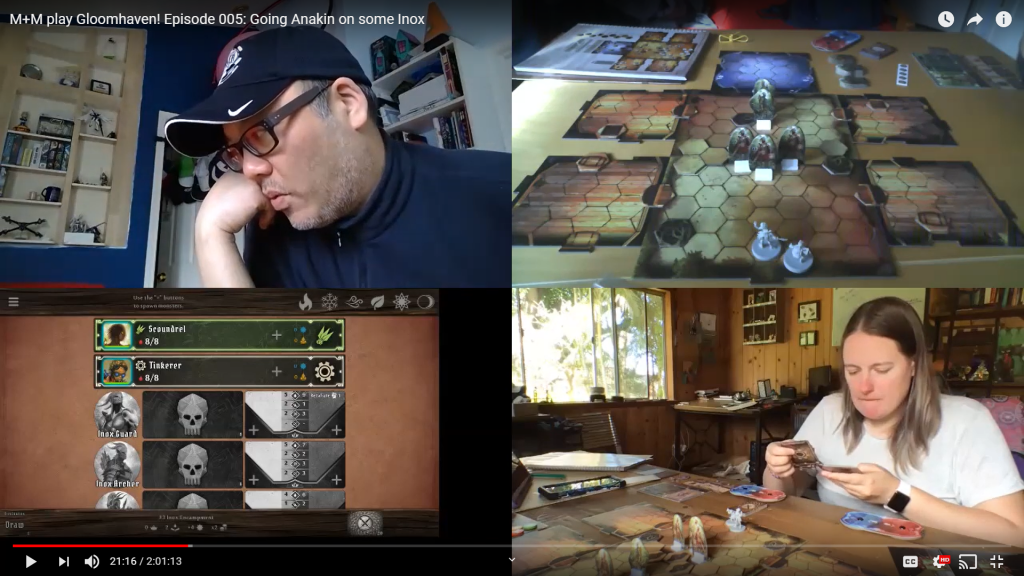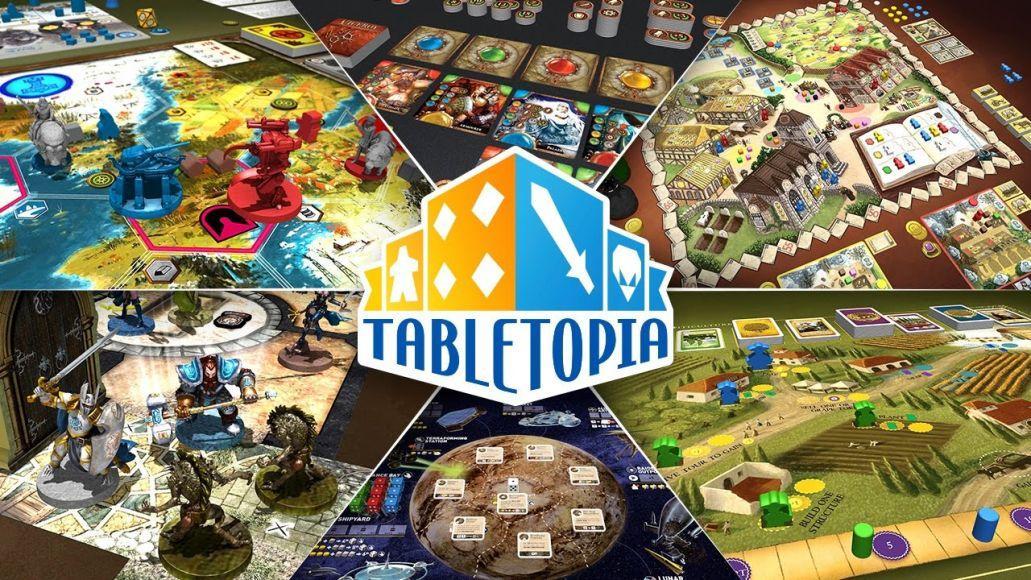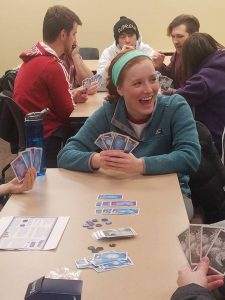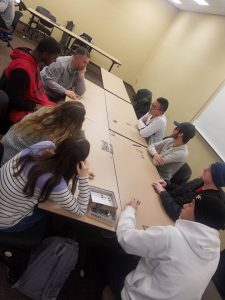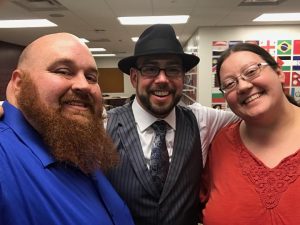There are several questions that I’ve received about the idea of this class from the earliest conception to now. Here are some of the most frequently asked questions I’ve received.
Tabletop games? Like ping pong? Or what?
Not like ping pong or billiards or air hockey or whatever. (I’m not joining the ongoing debate on if those count as tabletop games. Instead I’ll just say they aren’t what we’re using in class.) Tabletop Games is the current term for the family of games that encompasses board games, card games, pen and paper role playing games, etc. Many people use the blanket term “board games.” However, as RPGs, card games, and more are not truly “board games” (there is no board) the term tabletop game has emerged and is most frequently used now.
What do tabletop games have to do with leadership?
This question should really start with what is leadership and move from there, so that’s what I’ll do. Realistically leadership involves everything. I don’t feel there is one correct definition for leadership. Leadership means many different things to many different people and I try to stress that in all of my classes. Personally I believe in a lot of what Drew Dudley says about leadership. His Leading with Lollipops Ted Talk is my favorite of all time, although I also agree with him on many of his other concepts. You can check out four of his Ted Talks to see what he has to say. I also agree with Simon Sinek and his concept we should “Start With the Why.” However, I would not say that either of these are the “correct” definition of leadership because I don’t believe there is one correct definition-I think each person has their own. I may not agree with some people’s thoughts on the topic but that doesn’t make it wrong.
So that brings us back to what does leadership have to do with tabletop games? Everything! Depending on the game there are tons of lessons that can be learned. If there wasn’t I wouldn’t be using them to teach a class. Just as you can observe the interactions between players on a Quidditch pitch and discuss leadership, you also can see the same thing with board games. Sometimes these interactions are a critical part of the game design, others it is the interactions the players experience while playing the game. An excellent example from EDL classes this past semester includes using the game Ultimate Werewolf to discuss the First Follower concept, to discuss the roles people take in groups and decision making, to evaluate trust in a group and much more. I’ll discuss more about student reactions to that later. Another example can be seen in using Captain Sonar to look at communications. Another way I used a game in class this past semester was creating my own questions based on student orgs for the game Say Anything to let students see how others perceived their organizations.
You just want to play games in class, right?
To start with-I won’t be playing the games. The students in the class will. Most of the time I’ll be serving as moderator/game master while games are going on. I can answer questions about the games, but want the students to experience the games with peers. That said, this is more than just playing games. Using active learning and games or activities to teach has been a hallmark of student affairs forever and is core to the EDL 290 family of courses. People have many different learning styles, but games are very effective at reaching a broad range of people.
So…in class each week students will play Life or Monopoly and…what?
First, no. We won’t be playing many “classic” older games. This class is based primarily around the renaissance in gaming that is currently happening. It could be said to have started in the mid-90s. Before that period there were good games, but the entire landscape changed in the mid-1990s. I believe the oldest game we are playing is from 1982 (Survive: Escape From Atlantis) but most of the games are from the past 10 years or so and many from the past five.
As for what students will do in class? We have selected games based on different leadership themes. They will play the game or games selected for that week. After playing we will discuss the games, leadership concept (both those that are the theme of the week as well as other aspects of leadership that came out during the game) and any other topics they want to discuss involving games and leadership. Some weeks we may also do a short activity, watch a video, etc. We will use this all together to look at both games and leadership in new and unique ways.
Board games? Aren’t those for kids?
Really?
Don’t you know it is the digital era? Why board games instead of video games?
I’ll answer this with a section directly from the grant we received from CTE to fund the class.
“This course is based around games for learning. Tabletop games are more popular now than ever before. Whether it is role playing games (http://www.timesfreepress.com/news/life/entertainment/story/2013/jul/29/after-40-years-popularity-tabletop-gaming-ri/114446/) or board games (http://www.economist.com/news/business/21669930-table-top-games-are-booming-video-game-age-not-twilight-sunrise) globally more people than ever before are sitting down at tables socially to play tabletop games both at home, at local game stores, at clubs and organizations and at board game cafes. (http://wtop.com/lifestyle/2016/02/board-game-cafes-and-bars-find-success-locally-worldwide/slide/1/) There are many reasons for this, including the fact that many people now spend their days working on computers and this allows them to spend their free time socializing away from computers. (http://aleteia.org/2016/05/20/whats-behind-the-surprising-trend-of-board-game-cafes/) Miami University has developed one of the top game design programs in the nation, which allows students to focus both on video and tabletop game design.”
So one of the primary reasons for this is tabletop games are more popular now than ever before. Another reason is much more practical-basing this class on video games and having a shared experience would be cost prohibitive for many students. Text books for students cost a lot-imagine if a PS4 was required for a class. Finally, the interactions of sitting around a table playing these games will give students a shared experience that will make for better and more authentic discussions. There is also a huge difference between face-to-face interactions vs digital ones. Using video games during winter or summer terms was discussed and could be something we consider in the future. However, I believe tabletop games to be a better way to get to the concepts we want to in this class.
Ok-you have the class. Will the students really learn anything from it? Isn’t this a waste of their time?
Yes, students will learn. I’m not going to ask you to trust me on that. Instead I’ll use feedback from some of the anonymous course evaluations from the past semester.
“The werewolf game was an interesting exercise of trust and leadership. The real leadership that I witnessed occurred during the debates of what the ghosts clues really meant.”
“I found it interesting how leaders naturally rose up in that game and others tended to follow. Once just one person recommended someone to kill off, others jumped on board. I was expecting more debate on these decisions but it seemed that if one person acted confident enough, others would follow suit. I am glad we had a chance to play this!”
“Relating this topic to the fairy tale activity, I think we learned a lot about communication. It showed that you need to stay on topic with communication and not beat around the bush but rather get to the point. Also, I thought it demonstrated how various members of a student org can have opinions that build on one another to create a nice finished product.”
“The games made it easy to understand basic concepts and issues real organizations face.”
“The games because it taught leadership in ways everyone could understand and wouldn’t be hindered by a language barrier.”
Can I force-add into the class?
Unfortunately, no. The main reason for this is the course size (24) was intentionally chosen based on player count for games. Many of the games we will be playing either have 4, 6, or 8 players as the player count. As such, we purchased the correct number of games to maximize our player count for games. For example, with Captain Sonar we will have three groups of eight players. If another person was added to the mix, they would not be able to participate in the game. There will be a few games that this will not be the case for, however most of the games fit this standard. So we will be capped at 24 each semester. We are considering teaching the course every semester (it was originally intended to just be a fall class) and potentially do a second session of the class some semesters. So many people wanted to register that I want to give people the chance to take the class if they are truly interested. And seeing as it is an elective that will count towards several majors and minors on campus, it will be good to give people the chance to take the class.
